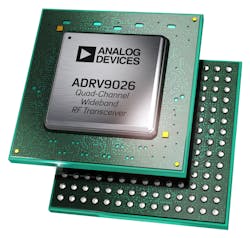Wideband transceiver supports multistandard 3G/4G/5G base-station applications
Download this article in .PDF format.
Base-station developers face a variety of challenges as 5G arrives, according to Peadar Forbes, marketing and applications director at Analog Devices. New 5G networks will need to support three use cases—extreme mobile broadband (eMBB), massive machine communication, and ultrareliable low-latency communication. Mobile broadband users will expect 100-Mb/s data rates wherever needed with peak rates extending to more than 10 Gb/s. And broadband 5G networks will serve 10 to 100 times more devices and experience 10,000 times more traffic, compared with previous generations.
Massive machine communications will require low-cost, low-power implementations that allow devices to operate on batteries for 10 years or more. And ultrareliable communication applications will require latencies of 1 ms or lower.
Forbes said Analog Devices’ base-station customers experience several pain points with respect to time to market and a huge increase in portfolio complexity and cost pressures. They are contending with multiple variants with respect to formfactors, frequency ranges, software variants, and antenna count, with high-density radios putting pressure on system size, weight, and power (SWaP).
Wideband transceiver
To help meet the challenges, Analog Devices in November 2019 introduced a new wideband transceiver in its RadioVerse1 design and technology ecosystem. The ADRV9026 is designed to support base-station applications including single and multistandard 3G/4G/5G macrocell base stations as well a massive MIMO (M-MIMO) and small-cell systems.
Forbes called the ADRV9026 the smallest, lowest power transceiver for base-station applications, describing it as a highly integrated, high-performance software-defined radio. Applications, he said, include macrocells, small cells, and massive MIMO architectures. He further described it as a common-platform design for 3G and 4G as well as 5G—thereby reducing complexity, development cost, and time to market.
Forbes said the ADRV9026 offers twice the integration and half of the power consumption of its predecessor, the ADRV9009. He said the ADRV9026 also supports FDD and TDD on a single chip to simplify development, whereas the ADRV9009 implementation required two chips for FDD.
Specifications include quad transmitters, quad receivers, and dual observation receivers with two inputs each, vs. dual transmitters, dual receivers, and one observation receiver for the ADRV9009.
Receiver bandwidth is 200 MHz, transmitter bandwidth and observation receiver bandwidth are 450 MHz. Tuning range is 650 MHz o 6 GHz.
Other features include a 16-Gb/s JESD204B/C interface, vs. 12-Gb/s JESD204B interface for the ADRV9009. Power consumption for the ADRV9026 is 5 W (under specified operating conditions), half that of the ADRV9009. The transceiver comes in a 14 x 14 BGA.
Forbes said Analog Devices offers several design resources for the ADRV9026, including 2.8-GHz to 6-GHz and 650-MHz to 2.8-GHz evaluation kits, carrier platforms, software (including a Windows GUI, API, and firmware), design-file packages (including EVB schematics, layout, BOM, Gerber, BSDL, IBIS, and S-parameter models), design tools (including JESD204B/C Framework IP, FPGA Interoperability Report, and Filter Wizard, all to be available in 2020), and customer support through the ADRV9026 EngineerZone Forum.
Forbes outlined the ADRV902X family roadmap, which includes the addition over time of 25-Gb/s SerDes support, an extension of the LO frequency range down to 75 MHz, support for an external LO, fast frequency hopping, and a filter wizard.
He said that in June 2020 an enhanced version from the ADRV902X family will be released with integrated DPD and CFR (crest factor reduction), reducing FPGA requirements and lowering total system power and cost. Also in June, he said, the company will launch an ADRV902X partner and reference design ecosystem.
The ADRV9026, ADI’s fourth-generation wideband RF transceiver, offers quad-channel integration with the lowest power, smallest size common-platform solution, the company said. The new software-defined transceiver supports both frequency-division duplex (FDD) and time-division duplex (TDD) standards, simplifying design and reducing system power, size, weight, and costs for 3G/4G/5G applications.
The RadioVerse design and technology ecosystem offers a one-stop radio design environment focused on simplifying the radio development process for a range of markets and applications. The RadioVerse ecosystem includes rapid prototyping platforms, chip-level evaluation systems, simulation tools, and development kits as well as a global partnership network that provides multiple levels of design support.
REFERENCE
1. Nelson, Rick, “Analog Devices expands RadioVerse design ecosystem,” EE-Evaluation Engineering Online, June 6, 2017.
Caption
Analog Devices’ ADRV9026 wideband transceiver, part of the company’s RadioVerse design and technology ecosystem.
Company mentioned
About the Author

Rick Nelson
Contributing Editor
Rick is currently Contributing Technical Editor. He was Executive Editor for EE in 2011-2018. Previously he served on several publications, including EDN and Vision Systems Design, and has received awards for signed editorials from the American Society of Business Publication Editors. He began as a design engineer at General Electric and Litton Industries and earned a BSEE degree from Penn State.
